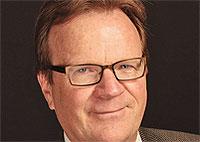WASHINGTON -- Up until the end of his life late Thursday at age 72, Clarence Ditlow fought tirelessly to force the auto industry and federal and state regulators to make cars, SUVs, pickups and minivans safer.
Over the span of his advocacy career, Ditlow and the Center for Automotive Safety, where he served as executive director, helped spur some of the highest-profile safety campaigns in history, including the recall of the Ford Pinto for exploding gasoline tanks and defective Firestone tires that undermined the handling of Ford’s popular Explorer in the late 1990s.
Ditlow’s death came after a yearlong battle with colon cancer, a staff attorney at the Center for Auto Safety said.
“He was a giant in the causes of safer more fuel-efficient, less-polluting motor vehicles, a 24-7 watchdog of the auto industry,” Ralph Nader, founder of the Center for Automotive Safety, said Friday. “He brought his engineering and legal skills to bear on the meticulous details of auto industry regulation and defect recalls. He held both industry and NHTSA accountable for their respective life saving missions.
“There would be many motorists who would not be as safe now. Clarence Ditlow was their exceptional guardian angel.”
This summer, while ailing with colon cancer, Ditlow took NHTSA to task over the issue of autonomous vehicles after a man was killed when his Tesla Model S collided with a truck.
“In its zeal to advance vehicle electronics, NHTSA has forgotten it is a regulatory agency to ensure vehicle safety, not a promotional agency to foster the development of new vehicle technology,” he wrote in a letter to NHTSA Administrator Mark Rosekind.
And in August, as deaths tied to defective Takata airbags mounted, Ditlow, a trained chemical engineer, called the Japanese auto supplier’s choice of ammonium nitrate to propel airbags “one of the biggest engineering mistakes in automotive history. Why are they still using it?”
‘You make them, I recall them’
In a speech last May honoring the 50th anniversary of Nader’s famous book, Unsafe at Any Speed, Ditlow got a laugh from the crowd when he recalled once telling Lee Iacocca over lunch: “You make them and I recall them.”
“He was really shy socially but he wasn’t shy about holding the car company’s feet to the fire, which was the reason nobody could dislike him,” Nader told Automotive News today. “They respected that.”
Joan Claybrook, a longtime Nader and Ditlow ally, a former head of NHTSA and president emeritus of Public Citizen, another Nader organization, called Ditlow’s death a great setback for auto safety.
“We were great and dear friends, it’s a terrible loss,” she said, adding Ditlow was relentless in his pursuit of making cars and light trucks safer.
One major case involved the Jeep Grand Cherokee. Fiat Chrysler Automobiles agreed to install trailer hitch assemblies on as many as 1.6 million 1993-98 Jeep Grand Cherokees and 2002-07 Jeep Libertys as part of a 2013 settlement with the National Highway Traffic Safety Administration after the agency requested a broader recall of those and other Jeeps.
After years of prodding by Ditlow and the Center for Automotive Safety, NHTSA initially alleged that the Jeeps were more prone to fire in some high-energy rear-impact collisions in part because their fuel tanks were located behind the rear axle. FCA objected to the allegations and initially refused the recall request, but ultimately settled on the trailer hitch fix. The automaker set aside $151 million from its earnings in 2013 to cover the cost of the campaign.
Said Claybrook: “One case after another he would evaluate. He filed endless FOIAs (Freedom of Information Act requests) with NHTSA. It would drive them crazy. Oh my God he worked so hard!”
"Spanning four decades, his work forced the auto industry to make vast improvements in the safety, reliability and fuel efficiency of the vehicles on which Americans depend daily," the Center for Auto Safety said in statement Friday.
"His accomplishments included safety recalls of tens of millions of vehicles that saved untold thousands of lives, and lemon laws in all 50 states. Since the center was founded in 1970, the death rate on America’s roads has dropped dramatically, from 5.2 per 100 million vehicle miles traveled in 1969 to 1.1 per 100 million vehicle miles in 2010. Ralph Nader and Consumers Union established the Center to provide consumers a voice for auto safety and quality in Washington and to help owners of 'lemon' vehicles fight back across the country."
Ditlow, the son of a Chevrolet service manager, was a chemical engineer and lawyer by training when he joined Nader’s group of activists in the late 1960s as a young attorney. The pack of lawyers came to be known as “Nader’s Raiders.” Ditlow, at Nader’s urging, became head of the center in 1976 and quickly championed seat belts, airbags and other advanced safety equipment.
Ditlow takes on GM
In the 1990s, the center played a central role in a highly controversial campaign to recall millions of large General Motors pickups equipped with so-called “side saddle” fuel tanks. The center described the trucks as “rolling firebombs” that were prone to catch fire in the event of a side-impact collision.
The C/K pickup, built between 1973 and 1987, was equipped with a gas tank mounted on the side of the truck outside of the frame. Ditlow and other critics said the design made the trucks more vulnerable than rival trucks in fiery, fatal crashes.
The company maintained that the pickups were safe and blocked U.S. efforts, at Ditlow’s urging, to recall them.
Harry Pearce, GM's top attorney at the time, used the fuel-tank debate to raise questions and reform the U.S. legal system and draw attention to some attorneys who use recalls to give credence to product-liability cases.
"The plaintiffs bar (attorneys) is driving this whole process," Pearce told The Chicago Tribune in 1993, adding automakers were often put on the hot seat by charges of defective design and or components. "More people need to ask how front organizations like Clarence Ditlow's Center for Auto Safety are funded. No doubt the majority comes from plaintiffs' bar," Pearce said.
“When GM starts complaining about critics,” Ditlow said at the time, “it is sending up a smoke screen to cover safety issues.”
The controversy was later fueled when the television newsmagazine “Dateline NBC” rigged a fiery explosion involving one of the vehicles. GM lawyers tracked down a truck used in the report in a junkyard and discovered it had been trumped-up for the demonstration. NBC was forced to issue an apology for the breach of journalistic ethics and reached a settlement with GM.
During the U.S. investigation into the trucks, Ditlow was sued for libel and slander by a former GM attorney who accused the safety watchdog of falsely claiming that the lawyer had ordered the shredding of company documents related to the trucks. The case was settled and the Center for Auto Safety’s insurer paid a reported $500,000, The Washington Post reported.
Ditlow and his lawyer were also fined $54,000 after they “brazenly ignored the court’s order” by releasing a sealed deposition to other lawyers pursuing a lawsuit against GM.
In 1994, the U.S. government and GM reached a settlement in which the government ended a recall investigation and the automaker agreed to pledge more than $51 million to U.S. auto safety efforts.
A decade later, Ditlow called the design of the big trucks the “worst auto crash fire defect in the history of the U.S. Department of Transportation.”
Rosekind applause
NHTSA’s Rosekind said Ditlow improved safety for anyone riding or driving a motor vehicle.
"Clarence was relentless in his pursuits, and whether he was taking the fight to the auto industry, or prodding NHTSA when he felt we weren’t moving fast enough, no one could ever doubt his heartfelt motivation," Rosekind said in a statement. "Americans are driving in cars that are safer thanks to Clarence, and his voice as an advocate for safety won’t easily be replaced."
Ditlow was married on Oct. 22, 2016, to his longtime companion, Marilyn Hermann. They had gotten to know each other in 1979 when she was working for the Environmental Protection Agency .
Claybrook said she had suggested to Ditlow that he finally get married and a celebration was held in the hospital.
She added: “Clarence didn’t have time to stop working to get married.”
David Phillips contributed to this report.







